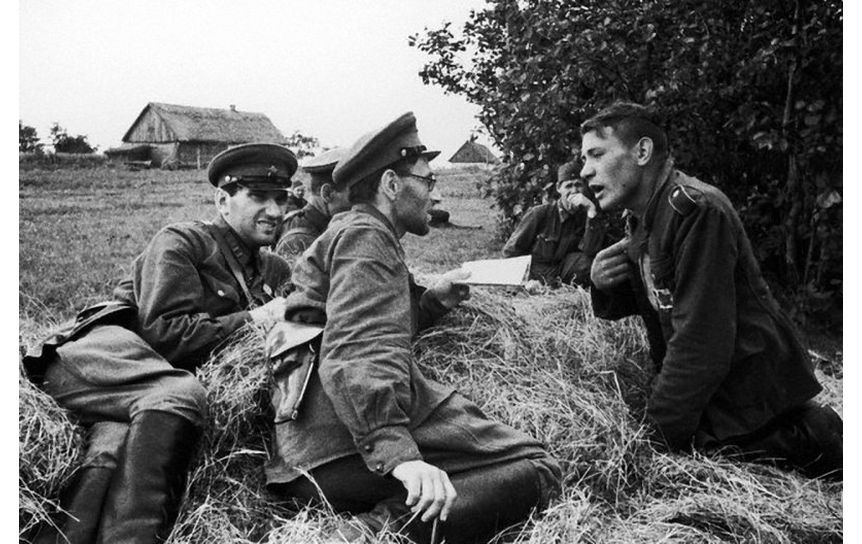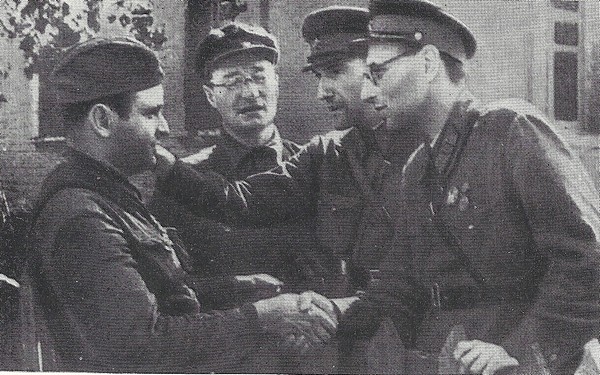The poet, writer, and journalist Boris Lapin was born in Moscow in 1905, in the family of a physician. His mother left the family and moved abroad, so she did not contribute to the upbringing of her son. In 1920, during the Russian Civil War, the fifteen-year-old Boris got to visit the front line – thanks to his father, who was working as a military physician, and who took his son along with him. In 1921, Lapin began to attend the Higher Literary and Artistic Institute in Moscow (the brainchild of the poet Valery Bryusov), but failed to graduate from it. He began to write poetry at a very early age, and was regarded as a child prodigy. At the age of seventeen, he led the avant-garde poetic society "The Moscow Parnassus" (1922), which produced its own poetic almanac, where Lapin published some of his poems. In those years, he actively assimilated the poetic experience of the major Russian poets of the preceding generation – e.g., Valery Bryusov, Vyacheslav Ivanov, and Alexander Blok. Like many avant-garde poets of the 1920s, he combined elements of European Romanticism, Russian Futurism, and German Expressionism in his work. He was one of the first translators of German Expressionist poetry (Jakob van Hoddis, Georg Heym, and Alfred Lichtenstein) into Russian.
Lapin had an exceptional linguistic aptitude, being fluent in numerous European languages (English, French, German, Polish, Bulgarian) and studying several "Oriental" languages (Farsi, Tajik, Mongolian, Chukchi, Urdu) on his own. From 1925, he wrote less poetry and more prose, as he traveled extensively throughout the country, visiting Alaska, the Russian Far East, and the Pamir region. Upon his return, he wrote a book of documentary prose, A Novel about the Pamir Country (1929). He could have stayed in Moscow, enjoying the status and perks of a Soviet writer, yet he chose a different path – joining a geobotanical expedition to the Karakum Desert, and then traveling to Mongolia and Japan. He enlisted in the navy as a navigator trainee, and went on to visit many ports in Europe and Asia. All these journeys gave him much material for his poetry and prose. In those years, he perpetrated a literary hoax, passing off his own work as translations of old Tajik and Japanese poetry (Poems on the Indian Frontier, 1932; The New Hafiz, 1933).
In 1932, he met another journalist and writer, Zakhar Khatsrevin, and the two became friends and collaborators for many years. The fruits of their professional relationship included not only journalistic essays, but also several books (America Borders on Us, Far Eastern Tales, The Adventures of the Brave Mongol, Summer in Mongolia, and others). In 1934, Lapin took part in an ambitious ideological project dreamed up by Stalin: writing the history of the construction of the White Sea-Baltic Canal. Although the canal was built by the forced labor of Gulag inmates, and is nowadays regarded as a prime example of state violence, this project was meant to showcase the greatness of socialist construction and serve as a successful model of rehabilitating criminals. The book about the canal, which was published in 1934, was a collection of essays by different authors. Lapin wrote the chapter titled "The Country and Its Enemies," which was particularly repugnant.
At the same time, Lapin continued writing his own prose and poetry. Ilya Ehrenburg recalled: "Lapin presented me with his book Pacific Diary. I liked it for its freshness and its mastery of the writer's craft. I was also fascinated by its author: He looked like an unassuming young academic, a very bookish type. In reality, however, he had travelled all over the world, readily exchanging the writer's desk for a swaying deck, a yurt, a border guard's hut" 1. In the mid-1930s, Lapin married Ilya Ehrenburg's daughter, Irina. At the time, he was already working as a correspondent for the central military newspaper, Red Star. In 1939, Lapin and Khatsrevin were dispatched by the newspaper to Khalkhin-Gol in Mongolia, to cover the ongoing military conflict between the USSR and Japan.
Ehrenburg would later recall Lapin as a very brave person, who actively courted danger. Further proof of Lapin's courage came after the outbreak of the Soviet-German War, when he and Khatsrevin were sent to the front by the editorial board of Krasnaya Zvezda ("The Red Star"). They toured various combat zones and produced a series of essays titled Letters from the Frontline. In his letters to his wife, Lapin listed the cities and regions that he intended to visit: Kremenchug, Chernigov, Gomel, Kiev. All of them lay on the frontline. In their essays, Lapin and Khatsrevin, like many other military correspondents, described notable events and aspects of the war. They lived among the soldiers, and were exposed to grave danger during the battles. They covered various current events: Kiev on the eve of the occupation, the daily life of the partisans, German POWs, the biographical sketch of a young pilot and his heroic exploits. David Ortenberg, the editor-in-chief of Krasnaya Zvezda, held their essays in high esteem. He recalled: "The frontline hustle and bustle did not prevent them from remaining true artists. It is known that, in such hectic times, we must write quickly, on the move. And yet, the essays of Lapin and Khatsrevin were always marked by intellectual depth and keen insight" 2
After the fall of Kiev, Lapin retreated from the city with the Red Army. Along with many other troops, he was trapped in the Kiev cauldron. There are several accounts of his death, but none of them explain why he made no attempt to escape from the encirclement. According to one version, he was reluctant to leave his friend and colleague Khartsevin, who had fallen seriously ill. Lapin was declared missing in action, and for a time his family hoped for his return. Some other correspondents of Krasnaya Zvezda perished along with him. After his death, several books of his prose were published in the Soviet Union. In 1976, a volume of poetry by Lapin and Khatsrevin (Only Poems) came out in Moscow.
Related Resources
Recollections about Boris Lapin
"Lapin and Khatsrevin left for the front line back in June. In August, they came to Moscow. Khatsrevin fell ill. The editorial board of Krasnaya Zvezda urged them on, and a week later they traveled back to Kiev. In early September, Lapin made a call from Kiev, joking, saying that we would probably meet again soon….
Lapin and Khatsrevin retreated from Kiev to Darnitsa with the troops, and they got as far as Borispol. The Germans encircled our units. Some soldiers managed to break out of the encirclement. From them, we would later learn the fate of Lapin and Khatsrevin. There was not a minute to spare, but Khatsrevin lay helpless, in the throes of yet another fit. Lapin refused to abandon his friend. "Hurry up! The Germans are getting close!" – a correspondent told him. Boris Matveyevich replied: "I have a revolver…" These were the last words by him to have reached me. Irina kept hoping for a miracle for a long time. Times of war inevitably give rise to myths: We kept receiving visitors who claimed to have seen Lapin on this or that front. Before leaving for Kiev, Boris Matveyevich made clean copies of his old poems. It may be that, even near Borispol, he kept hearing the music of those words, the unwritten stanzas – he was a poet, albeit a bashful one, reluctant to show his emotions, indulgent to others, but never to himself."
From: Ilya Ehrenburg, People, Years, Life [Sovetskii pisatel', 1990], vol. 2, pp. 243, 246.
A passage from the essay of Lapin and Khatsrevin
An essay titled "Kiev in These Days" was written on September 17, 1941, two days before the fall of the city on September 19. This was the last essay of Lapin and Khatsrevin, before their deaths in the encirclement east of Kiev. The authors' description follows the classical tradition of Russian literature. The image of the beautiful, eternal city is juxtaposed with the new reality of the war: Kiev is at once severe, furious, and gorgeous; prepared for deadly combat and designed for a peaceful life. This artful essay became their farewell to the Ukrainian capital.
"Kiev is wonderful in September. The first yellow leaves appear on the chestnut and linden trees. The autumn has set them on fire. A new crowd is milling on the sidewalks of Kiev – the militiamen in their military smocks. You would find much to surprise you in this austere city, where the pavement is crisscrossed with barricades. The Kreshchatyk is as crowded and noisy as ever. It is hosed, washed, and scrubbed clean every morning. However, this job is no longer performed by men, but by women. From time to time, the loudspeakers thunder along the street: "Attention! This is the Headquarters of the Kiev Anti-Aircraft Defense speaking." Fascist aircraft are flying over the city, and the AA guns are firing at them.… We are passing through the workers' settlement of this Ukrainian Red Presnya. We turn from the main thoroughfare, which is filled with the clanging of trams, into the side alleys. We see wooden houses with benches near the wicket gates. The bare, yellow, sandy hills peek from behind the roofs of the buildings. All the lanes are filled with makeshift barricades erected by the local residents. No one has shirked the defensive work. This, then, is the present-day Kiev – an austere, toiling, furious, immortal Soviet city. The militiamen; the nurses evacuating the wounded; the veteran workers of the Arsenal Factory, who must now, after twenty years of peace, take up the gun once again, and who are carrying clusters of grenades on their belts; the cannons looming in the courtyards; the Red Army units; the public parks; the people queuing up to buy tickets to the circus – all this is our Kiev, our heroic Kiev."
From: Krasnaya Zvezda, September 18, 1941.








